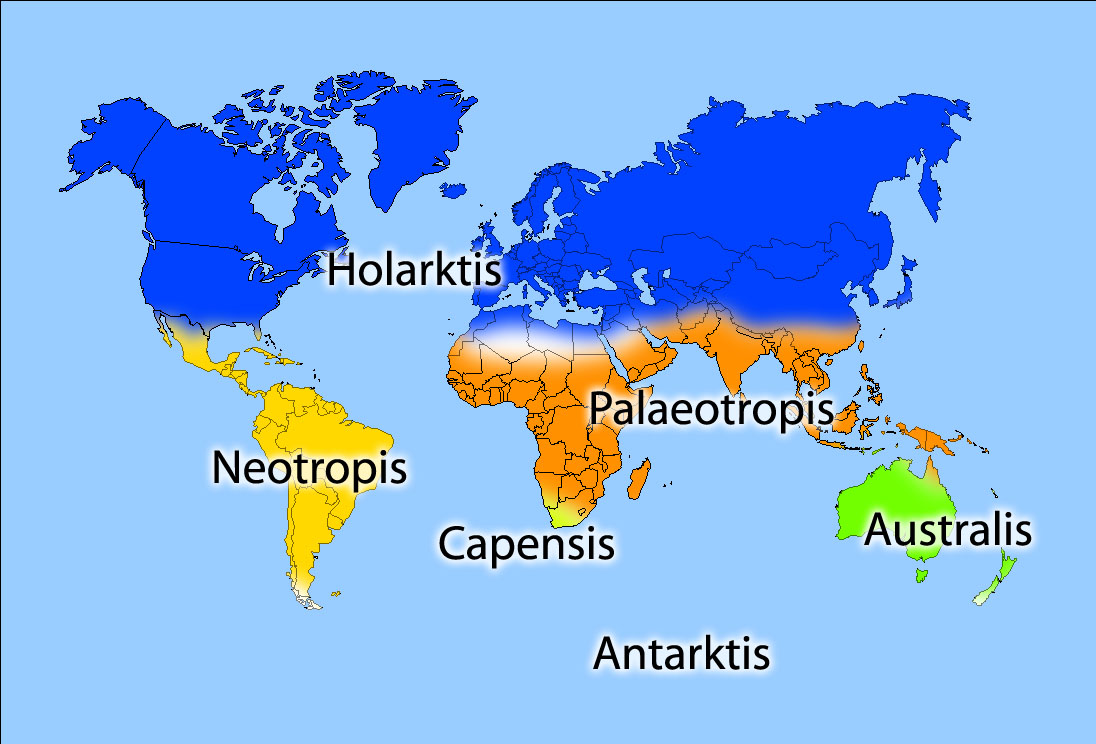|
Madrean
The Madrean Region (named after the Sierra Madre Occidental) is a floristic region within the Holarctic Kingdom in North America, as delineated by Armen Takhtajan and Robert F. Thorne. It occupies arid or semiarid areas in the southwestern United States and northwestern Mexico and is bordered by the Rocky Mountain Region and North American Atlantic Region of the Holarctic Kingdom in the north and in the east, Caribbean Region of the Neotropical Kingdom in the south. The Madrean Region is characterized by a very distinct flora with at least three endemic families (Fouquieriaceae, Simmondsiaceae, and Setchellanthaceae). Crossosomataceae, Garryaceae, Lennoaceae, Limnanthaceae and Stegnospermataceae have their principal development here; for Onagraceae, Polemoniaceae and Hydrophyllaceae it is the major center of diversity. More than 250 genera and probably more than half of the species of the region are endemic to it according to Takhtajan. Floristic provinces The region is subdivide ... [...More Info...] [...Related Items...] OR: [Wikipedia] [Google] [Baidu] |
Sierra Madre Occidental
The Sierra Madre Occidental is a major mountain range system of the North American Cordillera, that runs northwest–southeast through northwestern and western Mexico, and along the Gulf of California. The Sierra Madre is part of the American Cordillera, a chain of mountain ranges (cordillera) that consists of an almost continuous sequence of mountain ranges that form the western 'sounds' of North America, Central America, South America and West Antarctica. Etymology The Spanish name ''sierra madre'' means "mother mountain range" in English, and ''occidental'' means "western", these thus being the "Western mother mountain range". To the east, from the Spanish ''oriental'' meaning "eastern" in English, the Sierra Madre Oriental range or "Eastern Mother Mountains" runs generally parallel to the Sierra Madre Occidental along eastern Mexico and the Gulf of Mexico. The range extends from northern Sonora, a state near the Mexico–U.S. border at Arizona, southeastwards to the Trans ... [...More Info...] [...Related Items...] OR: [Wikipedia] [Google] [Baidu] |
Floristic Region
A phytochorion, in phytogeography, is a geographic area with a relatively uniform composition of plant species. Adjacent phytochoria do not usually have a sharp boundary, but rather a soft one, a transitional area in which many species from both regions overlap. The region of overlap is called a vegetation tension zone. In traditional schemes, areas in phytogeography are classified hierarchically, according to the presence of endemic families, genera or species, e.g., in floral (or floristic, phytogeographic) zones and regions, or also in kingdoms, regions and provinces, sometimes including the categories empire and domain. However, some authors prefer not to rank areas, referring to them simply as "areas", "regions" (in a non hierarchical sense) or "phytochoria". Systems used to classify vegetation can be divided in two major groups: those that use physiognomic-environmental parameters and characteristics and those that are based on floristic (i.e. shared genera and species) rela ... [...More Info...] [...Related Items...] OR: [Wikipedia] [Google] [Baidu] |
North American Atlantic Region
North American Atlantic Region is a floristic region within the Holarctic Kingdom identified by Armen Takhtajan and Robert F. Thorne, spanning from the Atlantic and Gulf coasts to the Great Plains and comprising a major part of the United States and southeastern portions of Canada. It is bordered by the Circumboreal floristic region in the north, by the Rocky Mountain and Madrean floristic regions in the west and by the Caribbean floristic region of the Neotropical Kingdom in the south of Florida. The flora of the region comprises two endemic monotypic families, Hydrastidaceae and Leitneriaceae, and is characterized by about a hundred of endemic genera (such as ''Sanguinaria'', ''Leavenworthia'', ''Gillenia'', '' Neviusia'', '' Dionaea'', '' Yeatesia'', '' Pleea''). The degree of species endemism is very high, many species are Tertiary relicts, which survived the Wisconsin glaciation and are now concentrated in the Appalachians (esp. Blue Ridge Mountains) and the Ozarks. A number ... [...More Info...] [...Related Items...] OR: [Wikipedia] [Google] [Baidu] |
Lennoaceae
Lennooideae is a subfamily of parasitic flowering plants of southwestern North America and northwestern South America. The relationships of this subfamily to other plants remain uncertain. It was traditionally treated at family rank as Lennoaceae, and placed in different orders by different authors, including Lamiales (in the Cronquist system) and Solanales (Dahlgren system). More recently, molecular phylogenetic publications grouped it within the clade "Euasterids I", and most recently, it was demoted to a subfamily of the family Boraginaceae in the APG II system. This subfamily has a disjunct distribution, occurring in Colombia as well as a separate area in southwestern North America, covering parts of California, Arizona and Mexico. It consists of up to three genera, '' Ammobroma'', ''Lennoa'' and ''Pholisma'', which among them hold around five species, including the desert Christmas tree, ''Pholisma arenarium'', and sandfood, ''Pholisma sonorae''. Members of this subfamily a ... [...More Info...] [...Related Items...] OR: [Wikipedia] [Google] [Baidu] |
Simmondsiaceae
Simmondsiaceae or the jojoba family is a family of flowering plants. The family is not recognized by all taxonomic systems, the single species, ''Simmondsia chinensis'', often being treated as belonging to family Buxaceae. The APG II system, of 2003 (unchanged from the APG system, of 1998), does recognize this family and assigns it to the order Caryophyllales in the clade core eudicots. It consist of a single species only, jojoba (''Simmondsia chinensis''), of North American shrubs. The Cronquist system, 1981, had also recognized this family and placed it in order Euphorbiales Euphorbiales is an order of flowering plants that is not currently recognized in the most authoritative modern treatment of plant taxonomy. In the APG II system (2003) the plants involved are mostly placed in the order Malpighiales. A well kno .... References External links Euphorbiales: an overview of the history Caryophyllales Caryophyllales families Monogeneric plant families {{C ... [...More Info...] [...Related Items...] OR: [Wikipedia] [Google] [Baidu] |
Setchellanthaceae
''Setchellanthus caeruleus'' is a species of pungent shrub with large blue flowers. It is placed alone in the genus ''Setchellanthus'', which is in turn, is placed alone in the family Setchellanthaceae. It is endemic to Mexico. The genus and the species were circumscribed by Townshend Stith Brandegee in Univ. Calif. Publ. Bot. vol.3 on page 378 in 1909. The genus name of ''Setchellanthus'' is in honour of William Albert Setchell (1864–1943), who was an American botanist and marine phycologist who taught at the University of California The University of California (UC) is a public land-grant research university system in the U.S. state of California. The system is composed of the campuses at Berkeley, Davis, Irvine, Los Angeles, Merced, Riverside, San Diego, San Francisco, ..., Berkeley, where he headed the Botany Department. The specific epithet ''caeruleus'' is the Latin for "blue".D. Gledhill References External links * http://www.mobot.org/MOBOT/Research/APweb/o ... [...More Info...] [...Related Items...] OR: [Wikipedia] [Google] [Baidu] |
Crossosomataceae
Crossosomataceae is a small plant family, consisting of four genera of shrubs found only in the dry parts of the American southwest and Mexico. This family has included up to ten species in the past, although as of 2021 six species are still recognised. ''Crossosoma'' are shrub-like plants which can vary from being 50 cm to 5 meters tall, with small alternating leaves that surround the stem, or leaves clustered in small spurts (fascicles).Richardson, P. (1970). Morphology of the Crossosomataceae. I. Leaf, Stem and Node. Bulletin of the Torrey Botanical Club, 97(1), 34-39. doi:10.2307/2483988 ''Apacheria'', however, has opposite leaves. ''Crossosoma'' has usually white flowers that are generally bisexual and have 5 petals attached to a nectary disk, but in ''Velascoa'' the flowers are campanulate and have an extremely reduced nectary disk. Genera *''Apacheria'' - one species, cliff brittlebush, '' Apacheria chiricahuensis'' *'' Crossosoma'' - two species, ''C. bigelovii' ... [...More Info...] [...Related Items...] OR: [Wikipedia] [Google] [Baidu] |
Stegnospermataceae
''Stegnosperma'' is a genus of flowering plants, consisting of three species of woody plants, native to the Caribbean, Central America, and the Sonoran Desert. These are shrubs or lianas, with anomalous secondary thickening in mature stems, by successive cambia. Leaves are alternate, entire, 2–5 cm in length, tapering at both ends. Flowers are small (5–8 mm), five-merous, with white petal-like sepals, and a superior ovary. They are arranged in short racemes, usually no more than 10 cm long, shorter in ''S. watsonii''. The fruit is a capsule 5–8 mm in diameter: it contains small (2–3 mm) black seeds with a conspicuous reddish aril. The genus has commonly been treated as belonging to the family Phytolaccaceae, but the APG system and APG II system, of 2003, regard it as the sole genus of its own family, the Stegnospermataceae and assign it to the order Caryophyllales in the clade core eudicots Turner et al. suggest that ''S. halimifolium'' Ben ... [...More Info...] [...Related Items...] OR: [Wikipedia] [Google] [Baidu] |
Limnanthaceae
The Limnanthaceae are a small family of annual herbs occurring throughout temperate North America. There are eight species and nineteen taxa currently recognized. Members of this family are prominent in vernal pool communities of California. Some taxa have been domesticated for use as an oil seed crop. Some members are listed as threatened or endangered and have been the focus of disputes over development plans (e.g. ''Limnanthes floccosa'' subsp. ''californica'', ''Limnanthes vinculans'' ) The Limnanthaceae are members of a recently identified clade (Brassicales) of mustard oil producing plants. They have a sharp flavor similar to mustard greens, radish or capers. (2003): An update of the Angiosperm Phylogeny Group classification for the orders and families of flowering plants: APG II. ''Botanical Journal of the Linnean Society'' 141(4): 399-436.PDF fulltext/ref> Two genera are recognized in the family. The monotypic genus ''Floerkea'' inhabits shaded, vernally wet habitats in e ... [...More Info...] [...Related Items...] OR: [Wikipedia] [Google] [Baidu] |
Family (biology)
Family ( la, familia, plural ') is one of the eight major hierarchical taxonomic ranks in Linnaean taxonomy. It is classified between order and genus. A family may be divided into subfamilies, which are intermediate ranks between the ranks of family and genus. The official family names are Latin in origin; however, popular names are often used: for example, walnut trees and hickory trees belong to the family Juglandaceae, but that family is commonly referred to as the "walnut family". What belongs to a family—or if a described family should be recognized at all—are proposed and determined by practicing taxonomists. There are no hard rules for describing or recognizing a family, but in plants, they can be characterized on the basis of both vegetative and reproductive features of plant species. Taxonomists often take different positions about descriptions, and there may be no broad consensus across the scientific community for some time. The publishing of new data and opini ... [...More Info...] [...Related Items...] OR: [Wikipedia] [Google] [Baidu] |

